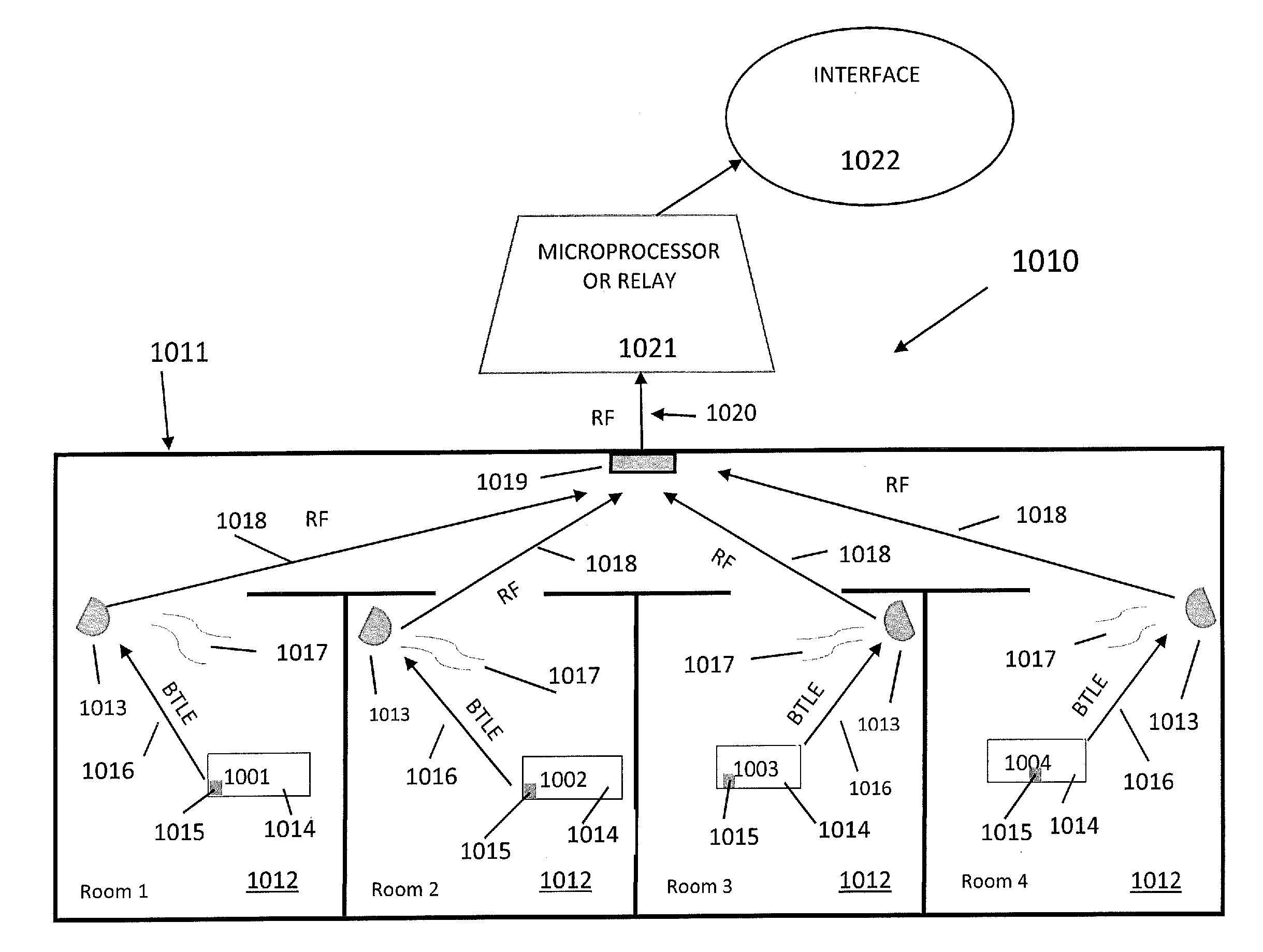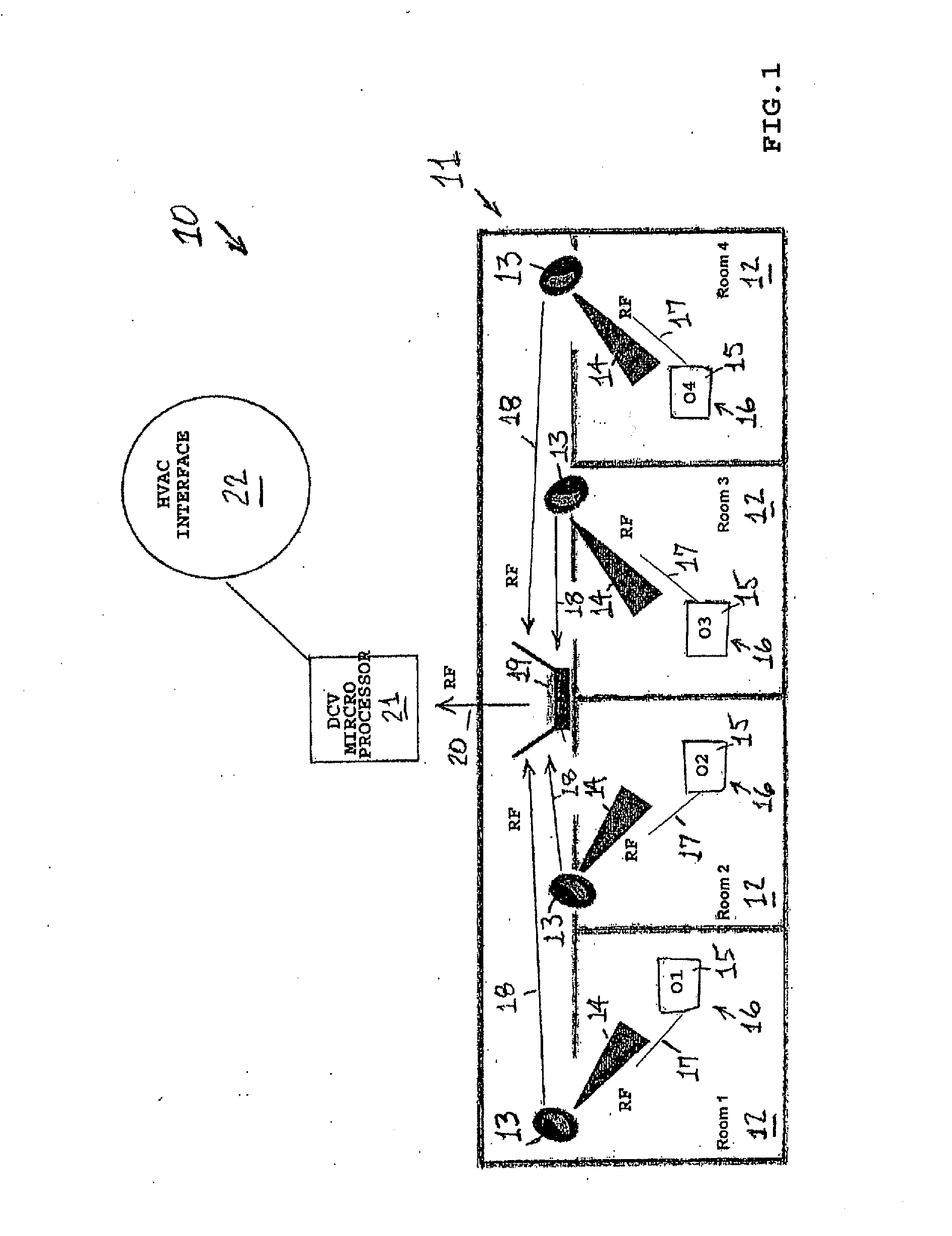Occupancy based demand controlled utility system
a utility system and occupancy-based technology, applied in the direction of static/dynamic balance measurement, wireless commuication services, high-level techniques, etc., can solve the problems of delay in shutting off lights and unnecessary energy consumption, and achieve the effect of significant energy efficiency, inexpensive and simple implementation
- Summary
- Abstract
- Description
- Claims
- Application Information
AI Technical Summary
Benefits of technology
Problems solved by technology
Method used
Image
Examples
first embodiment
[0047]FIG. 1 depicts a schematic apparatus configuration of the present invention 10, which uses passive tags. For illustrative purposes, this figure focuses on one ventilation zone 11 of a building that has multiple ventilation zones. The same basic apparatus configuration would be replicated in the other ventilation zones of the building. The exemplary ventilation zone 11 comprises four rooms 12, which are labeled Rooms 1-4. Obviously, depending on the floor plan and ventilation system of the building, each ventilation zone 11 can have more or fewer rooms 12 than are depicted in this figure. Hence, the number of rooms 12 indicated here is for illustrative purposes only.
embodiment 10
[0048]In each room 12, there are one or more sensors that are tag readers 13. There is one tag reader 13 per room 12, but multiple tag readers 13 may be required for rooms that are very large and / or have very complex configurations. In the preferred embodiment 10, the tag reader(s) 13 in each room 12 continuously transmit(s) RF search signals 14 throughout the room 12. The search signals 14 are detected by passive RFID tags 15 implanted in ID badges 16 issued to all building occupants and visitors. The RFID tags 15 respond to the search signals 14 by transmitting RF tag signals 17 back to the tag reader 13. The tag signal 17 for each RFID tag 15 transmits a digital ID code assigned to the particular ID badge 16 in which the RFID tag 15 is implanted. The tag reader(s) 13 then compile a running list of ID codes associated with the RFID tags 15 that are present in the room 12.
[0049]The tag reader(s) 13 in each room 12 at specified intervals transmit(s) RF reader signal(s) 18 to a zonal...
second embodiment
[0056]FIG. 3 depicts a schematic apparatus configuration of the present invention 10, which uses active tags. For illustrative purposes, this figure focuses on one ventilation zone 11 of a building that has multiple ventilation zones. The same basic apparatus configuration would be replicated in the other ventilation zones of the building. The exemplary ventilation zone 11 comprises four rooms 12, which are labeled Rooms 1-4. Obviously, depending on the floor plan and ventilation system of the building, each ventilation zone 11 can have more or fewer rooms 12 than are depicted in this figure. Hence, the number of rooms 12 indicated here is for illustrative purposes only.
[0057]In each room 12, there are one or more sensors that are infra-red (IR) emitters 13. There is one IR emitter 13 per room 12, but multiple IR emitters 13 may be required for rooms that are very large and / or have very complex configurations. In the embodiment 10, the IR emitter(s) 13 in each room 12 continuously e...
PUM
 Login to View More
Login to View More Abstract
Description
Claims
Application Information
 Login to View More
Login to View More - R&D
- Intellectual Property
- Life Sciences
- Materials
- Tech Scout
- Unparalleled Data Quality
- Higher Quality Content
- 60% Fewer Hallucinations
Browse by: Latest US Patents, China's latest patents, Technical Efficacy Thesaurus, Application Domain, Technology Topic, Popular Technical Reports.
© 2025 PatSnap. All rights reserved.Legal|Privacy policy|Modern Slavery Act Transparency Statement|Sitemap|About US| Contact US: help@patsnap.com



